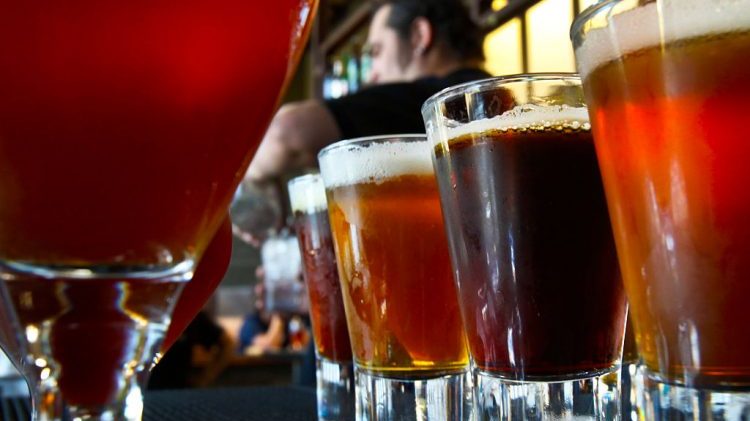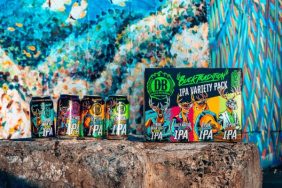Photo: Mark Boster/Los Angeles Times (Getty Images)
The IPA (or India Pale Ale) is arguably the most popular craft beer style in the U.S. Though the bitter, hop-fueled beer sells really well, it still has haters. There are many beer drinkers who have had enough of this kind of brew. Part of the distaste (get it?) for the style is a view that all IPAs are bitter. This is definitely not the case, at least not anymore.
Still, India Pale Ales and all of their iterations amount to over 35 percent of all craft beer sold in the U.S. “IPAs certainly have come a long way since their origin story back in 1975 when Anchor Brewing Company released ‘Liberty Ale,’ an IPA, during the first wave of craft beer,” says Shaun O’Sullivan, co-founder and brewmaster of 21st Amendment Brewery. Today, almost all craft breweries have more than one IPA in their line-up. “You even see breweries where entire tap lists are dominated by IPAs in all forms, and other styles of beer are in the minority.”
Although IPA continues to be a popular and evolving style of beer in America, it’s interesting to note that IPAs are still only a small portion of the overall beer sold in America. “IPA accounts for only 2 percent of the volume and 4 percent of the dollars of overall beer sold when looking at the entire beer market in the US,” says Scott Ungermann, brewmaster at Anchor Brewers and Distillers, LLC.
Pushback Against Bitter Beer
Technically, there’s no real pushback against IPAs. In fact, it’s quite the opposite, but we are seeing changes to the bitter hop-bombs that many people know as IPAs. “You are seeing new sub-styles such as fruit IPAs, juicy/hazy IPAs and Brut IPAs, and there is a sense the style is continuing to evolve and expand with new flavors and interpretations,” says O’Sullivan.
There has also been a resurgence of brewing crisp, highly drinkable lagers and cream ales and other lighter styles of beers with lower hops, but it’s more of a balancing act than actual pushback. “Brewers want to make beers for all beer drinking occasions, and there are times that call for other styles,” says Ungermann.
New Brews: Everything You Need To Know About Bourbon County’s 2018 Releases
If people are tired of the intense hop presence of IPA, the other end of the beer spectrum is the “malt dominated” categories. “This time of year is especially good for the styles of beer that exhibit malt over hops, or a good blend of both: amber ale, porter, stout, doppelbock, scotch ale, barley wine, etc.,” says Jeremy Williams, lead mixologist at Lumber Baron Bar in Grand Rapids, Michigan. “Lots of these styles still have hops to balance the malt but the hop presence still gives way to the rich, toasty grain character with roasted accents and also often nuttiness and fruit character.”
Do Hops Equal Bitterness?
When adding hops to the kettle at the beginning of the boil during the brewing process, you are extracting hop resins and adding bitterness to the beer. “In the new wave of IPAs, such as hazy IPAs, there is an emphasis on removing a substantial amount of the early bittering hops and increasing hop additions late in the boil as well as in the fermenter where hop oils and the abundance of hop green matter dominate,” he says. “This adds hop flavors (not bitterness) and hop aromas.” So hops don’t necessarily mean bitterness as the new era of IPA is showing us.
“Brewers with this new style are also adding malts with a higher percentage of protein (flours, flaked oats, wheat) giving a fullness and turbid cloudiness appearance that help suspend hop flavors and aromas and also give a silkiness to their flavor profile,” says O’Sullivan.
How Has The IPA Changed Over The Years?
The original IPAs were brewed in England for export to India in the 19th century. “By the mid-20th Century, the style was an unknown historical relic in the U.S., but was still being brewed by a few brewers in England,” says Ungermann. When Fritz Maytag (former owner of Anchor Brewing) decided in 1975 that he wanted to make a hoppy Pale Ale, he revived the technique of dry-hopping and started a revolution with Liberty Ale. “All modern American IPAs trace their roots to this remarkable beer,” he says.
The style has completely evolved in the last decade with new sub-styles such as Session (lower ABV) IPAs, black IPAs, double IPAs, triple IPAs, juicy/hazy West Coast IPAs, fruit IPAs and the like. “It’s not your father’s IPA any more people,” says O’Sullivan.
Why Do Some People Think They Hate IPAs?
If you’re not a fan of IPAs, it’s probably because bitterness turns you off. “I would recommend a fruited IPA, like our Blood Orange Brew Free! or Die IPA,” says O’Sullivan. “Citrus fruits, like blood orange, offer a pleasant note and perceived sweetness that’s more inviting and hops complement the fruit note.” Other options are juicy or hazy IPAs. “They are less bitter and have a sweetness about them, coupled with big hop aroma and flavor,” he says. Brut IPAs are great as well as they have a low finishing gravity, are quite dry and champagne-like with hoppy characteristics.
Goals: Guy Balances Eight Beers While Eating A Bratwurst
Session IPAs are also a great choice for novices because of the lower alcohol, less bitterness, but the same hop presence. “The question to ask anyone who does not like a particular beer is: why not?” says Ungermann. “If it was too bitter, try a less bitter one. With so many styles available, chances are you will find one you like.”
There Are Still Bitter Fans Out There
Even with the alternatives, there will always be a market for classic, hop-heavy IPAs, like Sierra Nevada Pale Ale and Bell’s Two Hearted. “I think the IPA still stands around the top of craft beer selections,” says Ben Rouse, bar lead at Henley in Nashville. “It seems like the O.G. craft brew. However, there are some styles coming close, Scotch Ale’s carry that body and flavor profile and Dunkel’s seem to be a little more present in our market.”
“People are not tired of IPAs,” says Margaret Salas, bartender at Grain and Cane in Berkeley Height, New Jersey. In fact, they are becoming more curious about them. “If an IPA is on draft and the guest has never heard of it, they will typically ask for a tasting and eight out of 10 times they will order it.”
IPAs Are Here To Stay
IPAs aren’t going anywhere any time soon, but that doesn’t mean you can’t branch out and try something else. You wouldn’t want to get sick of IPAs, would you? “IPAs are going to be around for a long time, but also try and enjoy a lager from your favorite craft brewery,” says O’Sullivan. “The return of the well-crafted lager is right around the corner and you’ll be ahead of the wave.”









